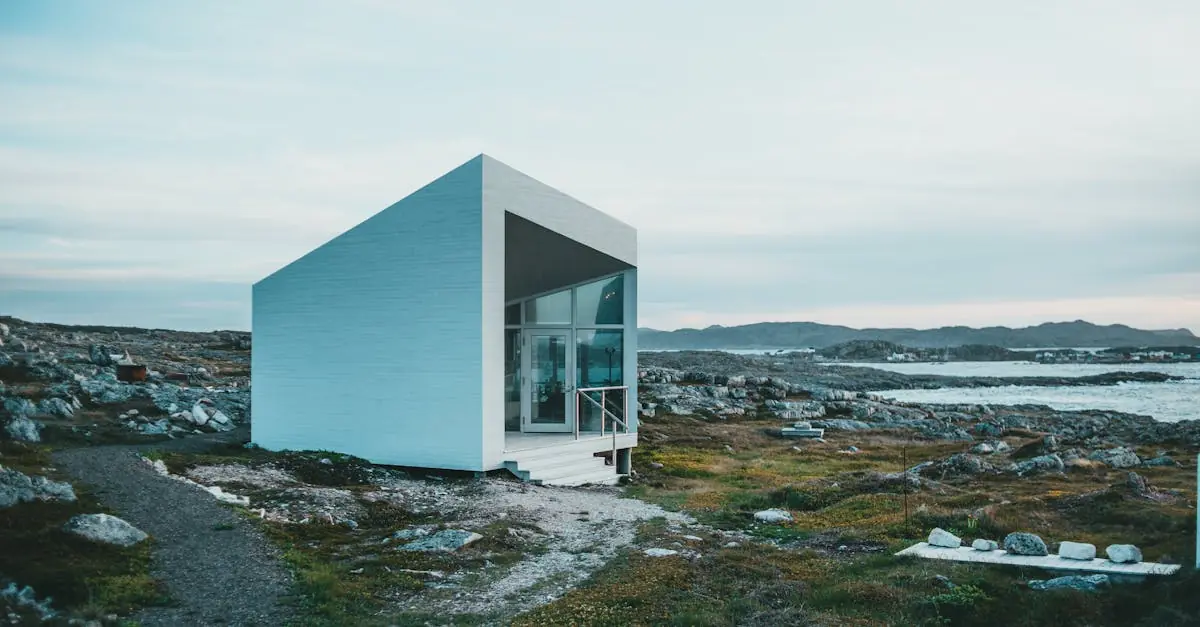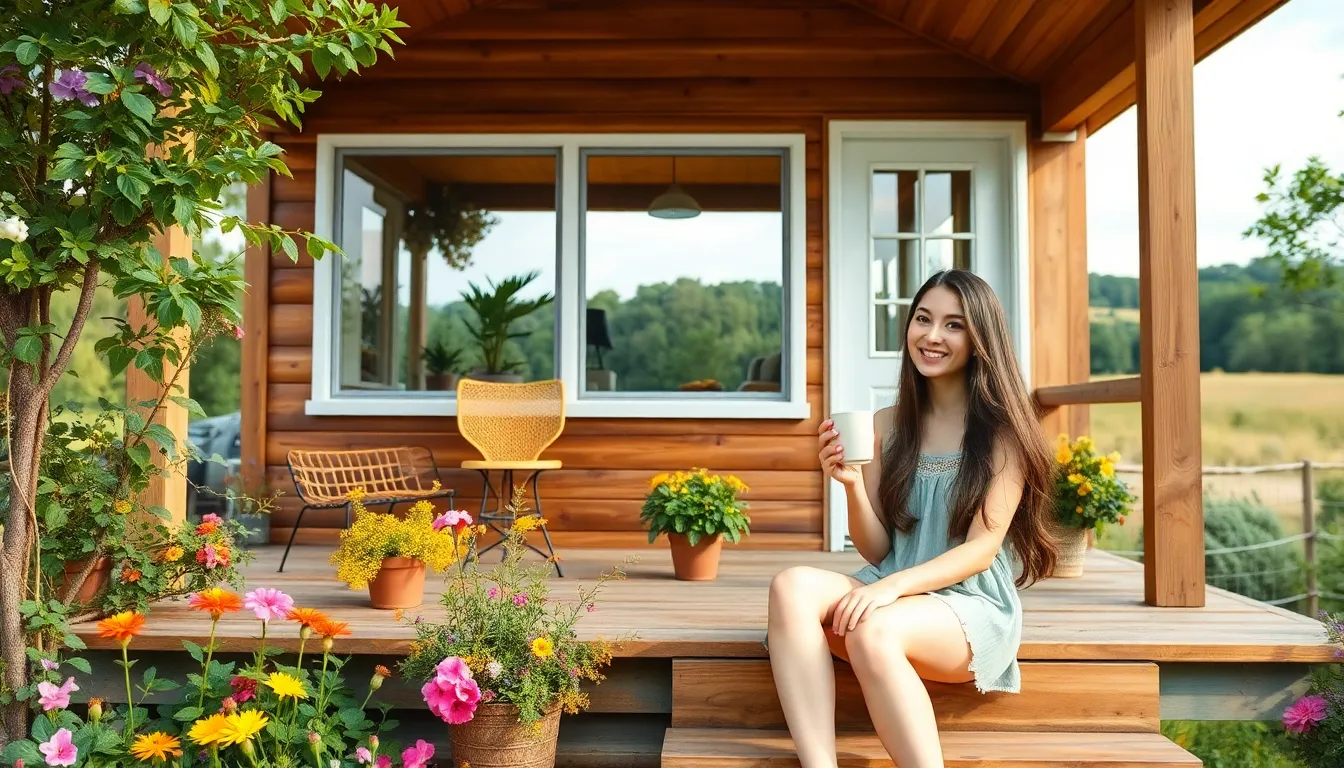Table of Contents
ToggleIn a world where bigger often seems better, the remote tiny home movement is flipping the script. Imagine living in a cozy, compact space surrounded by nature, where your biggest dilemma is whether to sip coffee on the porch or take a hike. Tiny homes offer a unique blend of simplicity and adventure, perfect for those looking to escape the daily grind without sacrificing comfort.
These pint-sized havens aren’t just about downsizing; they’re about upgrading your lifestyle. With fewer square feet to clean and maintain, residents find themselves with more time for what truly matters—like perfecting their s’mores technique or finally learning to play that ukulele gathering dust. Join the tiny home revolution and discover how living small can lead to living large in the great outdoors.
Overview of Remote Tiny Homes
Remote tiny homes offer unique living solutions that blend simplicity with nature. Designed to minimize living space, these homes provide all essentials without unnecessary excess. Many individuals embrace this lifestyle to escape urban chaos, seeking tranquility and a deeper connection to the environment. Smaller footprints correlate with reduced environmental impact, making tiny homes an eco-friendly option.
Compact layouts often feature multi-functional furniture, maximizing usability while maintaining comfort. Remote locations inspire creativity and encourage outdoor activities, enhancing residents’ overall well-being. Surrounding landscapes ranging from forests to mountains create idyllic settings, contributing to a serene lifestyle.
Efficient energy use is common in remote tiny homes, with many incorporating solar panels or sustainable materials. Minimal maintenance not only saves time but also lowers costs, allowing more freedom for leisure pursuits and hobbies. The community surrounding remote tiny homes tends to value shared experiences and collaboration, fostering lasting relationships among neighbors.
Flexibility remains a central appeal. Many choose to relocate their tiny homes as needs evolve, offering a unique sense of freedom. Constructing a remote tiny home often includes customization options, reflecting personal tastes and preferences. This combination of simplicity, efficiency, and personal expression leads to improved quality of life.
Remote tiny homes challenge conventional living standards, providing a new perspective on what home truly means. As this lifestyle gains popularity, it continues to attract those seeking a mindful, fulfilling existence in harmony with nature.
Advantages of Remote Tiny Living
Remote tiny living offers numerous benefits that enhance quality of life while promoting a sustainable lifestyle.
Cost-Effectiveness
Living in a remote tiny home significantly reduces housing expenses. Lower initial costs mean less financial stress for homeowners. Reduced utility expenses come from smaller spaces that require less energy to heat or cool. Maintenance costs diminish as fewer materials and simpler designs minimize upkeep. Many tiny homes come equipped with multi-functional furniture, maximizing functionality and reducing the need for additional purchases. Financing options often appear more manageable, allowing owners to avoid overwhelming debt. Overall, the cost savings from embracing tiny living contribute to a more enjoyable and flexible lifestyle.
Eco-Friendly Lifestyle
Remote tiny homes promote an eco-friendly lifestyle through their smaller environmental footprints. These homes use sustainable materials, reducing the demand for non-renewable resources. Most designs emphasize energy efficiency with features such as solar panels and rainwater collection systems, lowering resource consumption. Many remote tiny homes optimize space through innovative layouts, encouraging less clutter and waste. This lifestyle fosters a closer connection to nature, as residents often find themselves surrounded by beautiful landscapes. Residents commonly engage in outdoor activities, reinforcing sustainable practices by appreciating the natural world. Embracing a tiny home connects individuals to eco-conscious living while preserving the planet for future generations.
Key Features of a Remote Tiny Home
Remote tiny homes offer a unique blend of downsizing and nature connection. Key features of these homes enhance their appeal for those seeking simplicity and tranquility.
Space Optimization
Space optimization makes the most out of compact living areas. Multi-functional furniture serves versatile purposes, allowing for a seamless flow from one area to another. Clever storage solutions keep essentials organized while minimizing clutter. Areas designed for relaxation, work, and dining reflect thoughtful layouts, encouraging efficient use of every square foot. Additionally, large windows create an illusion of more space and provide natural light. Balconies or outdoor decks extend living areas, merging indoor and outdoor experiences.
Off-Grid Capabilities
Off-grid capabilities empower remote tiny homes to operate independently of public utilities. Solar panels often provide renewable energy, drastically lowering electricity costs. Rainwater harvesting systems collect water, promoting sustainable living practices. Composting toilets minimize water usage while supporting eco-friendly waste management. In remote areas, reliable heating systems, such as wood stoves or propane heaters, ensure comfort year-round. Battery storage systems allow homeowners to harness energy efficiently, even on cloudy days. Emphasis on self-sufficiency becomes essential for those seeking a true escape from urban life.
Popular Locations for Remote Tiny Homes
Mountainous regions attract many tiny home enthusiasts due to their breathtaking views and serene environments. Areas like the Rockies in Colorado and the Smoky Mountains in Tennessee offer both stunning landscapes and proximity to outdoor activities. Nearby national parks enhance the appeal, providing ample opportunities for hiking and exploring nature.
Coastlines also draw those seeking remote tiny living. Locations in Maine and Northern California grant access to the ocean while maintaining a tranquil atmosphere. Beachfront views and the soothing sounds of waves contribute to a peaceful lifestyle.
Forest settings provide another popular choice for remote tiny homes. The lush forests in Oregon and Washington allow residents to immerse themselves in nature. The dense woodlands support biodiversity, creating a perfect backdrop for those who enjoy wildlife and tranquil surroundings.
Desert areas attract individuals searching for unique experiences in remote tiny homes. The deserts in Arizona and New Mexico offer expansive landscapes and warm climates, appealing to those who prefer minimalistic living with a distinctive character. Residents often enjoy stargazing in these low-light pollution zones.
Lakeside locations also serve as ideal spots for remote tiny homes. Regions like Minnesota’s lake country and the Finger Lakes in New York provide stunning water views and recreational opportunities. Lakes support activities such as kayaking, fishing, and swimming, enhancing the tiny home lifestyle.
These diverse locations cater to various preferences, enabling individuals to choose a setting that aligns with their desired lifestyle. The enhanced connection to nature and unique surroundings contribute to the overall tiny home experience, promoting a fulfilling and simplified way of living.
Challenges of Living in a Remote Tiny Home
Living in a remote tiny home presents several challenges that potential residents should consider. From accessibility issues to maintenance concerns, these factors can impact the overall experience.
Accessibility Issues
Remote tiny homes may pose significant accessibility challenges. Narrow roads often lead to these locations, making transportation difficult, especially during inclement weather. Limited access to public services, such as emergency responders, can also raise safety concerns. Additionally, some tiny homes may not comply with building codes, shaping limitations for those with mobility impairments. Accessibility to resources like grocery stores and healthcare facilities often results in longer travel times, emphasizing the need for careful planning.
Maintenance Considerations
Maintenance in remote tiny homes can present noteworthy challenges. Limited space often requires creative solutions for storage and organization. Frequent maintenance of off-grid systems, such as solar panels and water filtration, demands regular inspections to ensure efficiency. Seasonal weather changes can exacerbate wear and tear, affecting the integrity of structures. Managing waste disposal responsibly in remote areas requires adherence to regulations, increasing the demand for diligent upkeep. Overall, residents must be prepared for ongoing maintenance efforts that can impact their living experience.
Embracing the remote tiny home lifestyle offers a unique opportunity to reconnect with nature and prioritize what truly matters. The simplicity of living in a compact space encourages individuals to focus on experiences rather than possessions. With eco-friendly designs and innovative solutions, these homes not only reduce environmental impact but also foster a sense of community among like-minded residents.
While challenges exist, the rewards of downsizing can lead to a more fulfilling and tranquil life. For those ready to escape the hustle and bustle of urban living, remote tiny homes present an enticing alternative that promotes sustainability and personal freedom. Exploring this lifestyle may just inspire a transformative journey towards mindful living.



